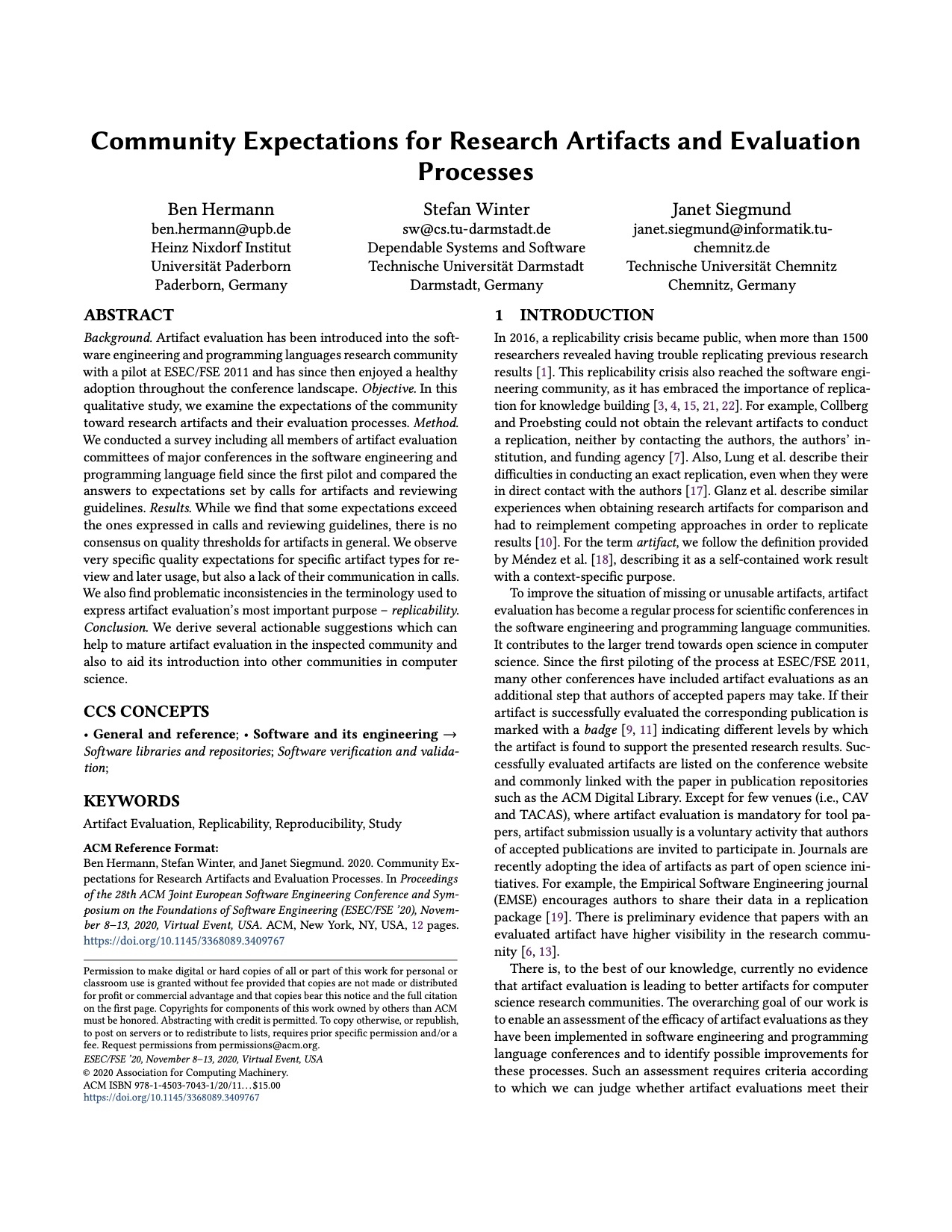This repository contains the material used in and produced during the study Community Expectations for Research Artifacts and Evaluation Processes accepted at the ACM Joint European Software Engineering Conference and Symposium on the Foundations of Software Engineering (ESEC/FSE) 2020.
Paper Abstract
Background. Artifact evaluation has been introduced into the software engineering and programming languages research community with a pilot at ESEC/FSE 2011 and has since then enjoyed a healthy adoption throughout the conference landscape.
Objective. In this qualitative study, we examine the expectations of the community toward research artifacts and their evaluation processes.
Method. We conducted a survey including all members of artifact evaluation committees of major conferences in the software engineering and programming language field since the first pilot and compared the answers to expectations set by calls for artifacts and reviewing guidelines.
Results. While we find that some expectations exceed the ones expressed in calls and reviewing guidelines, there is no consensus on quality thresholds for artifacts in general. We observe very specific quality expectations for specific artifact types for review and later usage, but also a lack of their communication in calls. We also find problematic inconsistencies in the terminology used to express artifact evaluation's most important purpose -- replicability.
Conclusion. We derive several actionable suggestions which can help to mature artifact evaluation in the inspected community and also to aid its introduction into other communities in computer science.
Paper Preprint
The paper preprint is available here:
Artifact Availability
The artifact is maintained as a GitHub repository.
It is versioned according to the state of the publication.
Released versions are automatically archived to Zenodo.
Version History
Contents
-
Calls for Artifacts
- Process Call Analysis Process and Datafile Description
- Data Raw Collected Calls for Artifacts (Collected Calls for Artifacts (CfA) of the inspected conferences.)
- Data Derived Artifact Evaluation Commitees (collected from CfAs) (Excel) - e-mail addresses removed
- Data Derived Text analysis results from calls of artifacts
- R Script Analysis script for CfA tags
-
Survey
- Process Survey Analysis Process and Datafile Description
- Survey (Our survey questions in printable form. Survey was filled out online.)
- Survey Questions (Excel) - used in scripts for relations to the survey
- Data Raw Raw result data file (Excel) - anonymized at F3
- Data Derived Card sorting results (Labels obtained with the open card sorting method.)
-
Plots
- R Script Committee sizes and responses (Figure 1)
- R Script Histogram of individuals by number of AECs served in (Figure 2)
- Output Figures (Figures derived from the collected data.)
-
Analyses
- R Script A helper script to distinguish responses by community
- R Script Analysis of questions with numeric answers
- Output Results from the analysis of numeric answers
- R Script Analysis of full-text answers using the tags from open card sorting
- Output Results from the analysis of open card sorting tags
- R Script Script to run both plots and both analysis scripts
Legend
- Data
- Data artifact
- Raw
- Raw data collected
- Derived
- Data derived from the collected data
- R Script
- Analysis script written in R
- Output
- Script output
- Process
- Process Description and Data Formats
Data File Formats
Data files are provided as CSV or Excel files. They can be read and processed with R or other capable environments (e.g. pandas, Excel itself, ...). The process description for the call analysis and the survey analysis contain format descriptions for the data files.
Requirements
The analysis script provided in this artifact require R to run. We were using R version 3.6.1 (2019-07-05) at the time of the study. The scripts make use of the following packages and were executed with the following versions of these packages:
| Package name | Version used |
|---|---|
| dplyr | 0.8.3 |
| ggplot2 | 3.2.0 |
| gsubfn | 0.7 |
| readxl | 1.3.1 |
| stringr | 1.4.0 |
| svglite | 1.2.3 |
| tibble | 2.1.3 |
| tidyr | 0.8.3 |
Executing scripts
All scripts will automatically install the necessary packages if not present in the current environment. However, there were cases in the past when functions were deprecated by the package authors. During the time of the study we did not experience such a case, but they might appear in the future.
To create the scripts and inspect results, we used RStudio.
Thus, the scripts may either be executed in RStudio or directly on the command-line.
For the latter, please use the following format:
R < scriptname.R --vanilla to avoid interference with other projects. The analysis/survey folder contains a convenient runall.R script to run all scripts for the analysis of survey results. Their
output will be placed in the analysis/survey/output folder. Warnings may occur, but were checked during development.
Sections of the Paper and their Relationship to the Artifacts
In the following table we show the relationship between the sections of the paper and the data and analysis artifacts provided here.
